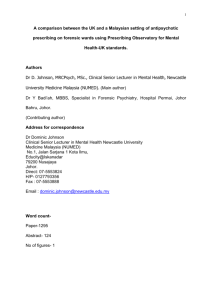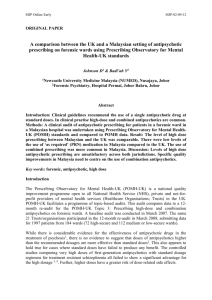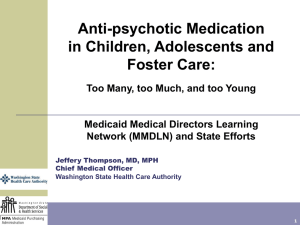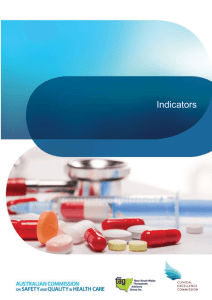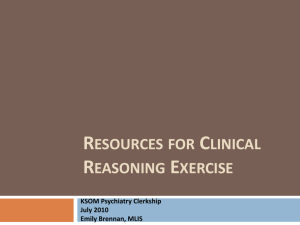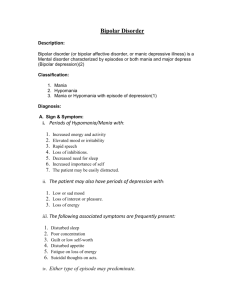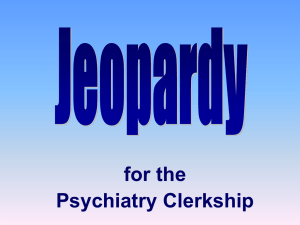Authors - Malaysian Journal of Psychiatry
advertisement
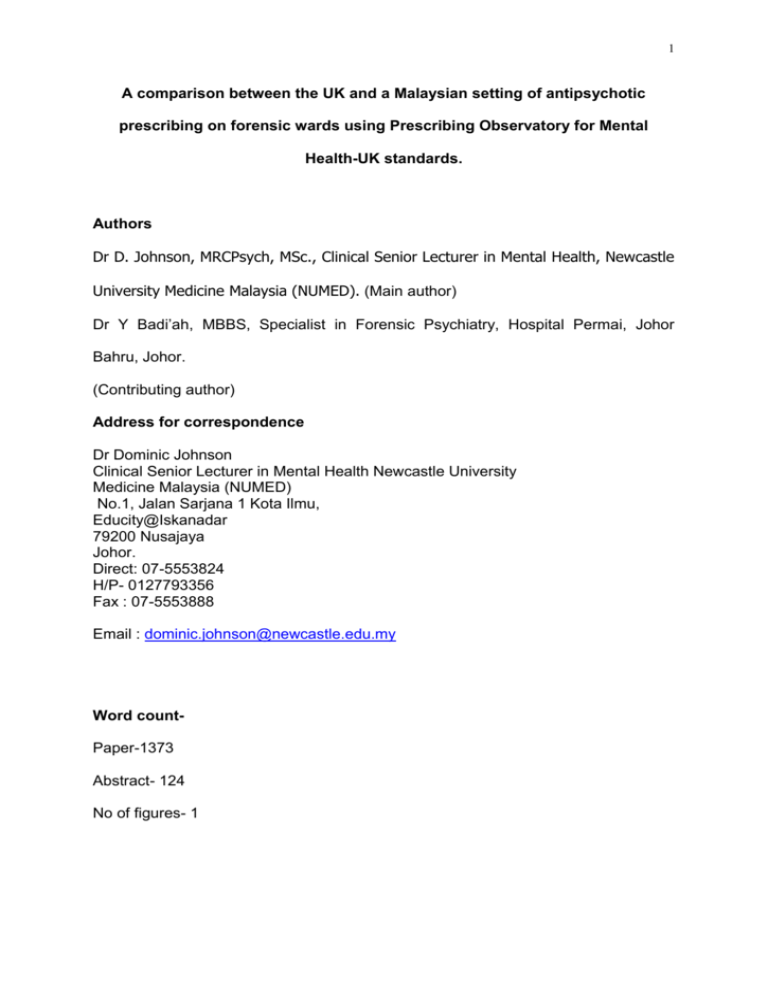
1 A comparison between the UK and a Malaysian setting of antipsychotic prescribing on forensic wards using Prescribing Observatory for Mental Health-UK standards. Authors Dr D. Johnson, MRCPsych, MSc., Clinical Senior Lecturer in Mental Health, Newcastle University Medicine Malaysia (NUMED). (Main author) Dr Y Badi’ah, MBBS, Specialist in Forensic Psychiatry, Hospital Permai, Johor Bahru, Johor. (Contributing author) Address for correspondence Dr Dominic Johnson Clinical Senior Lecturer in Mental Health Newcastle University Medicine Malaysia (NUMED) No.1, Jalan Sarjana 1 Kota Ilmu, Educity@Iskanadar 79200 Nusajaya Johor. Direct: 07-5553824 H/P- 0127793356 Fax : 07-5553888 Email : dominic.johnson@newcastle.edu.my Word countPaper-1373 Abstract- 124 No of figures- 1 2 Abstract Introduction Clinical guidelines recommend the use of a single antipsychotic drug at standard doses. In clinical practise high-dose and combined antipsychotics are common. Methods A clinical audit of antipsychotic prescribing for patients in a forensic ward in a Malaysian hospital was undertaken using Prescribing Observatory for Mental HealthUK (POMH) standards and compared to POMH data. Results The level of high dose prescribing between Malaysian and the UK was comparable. There were low levels of the use of ‘as required’ (PRN) medication in Malaysia compared to the UK. The use of combined prescribing was more common in Malaysia. Discussion Levels of high dose antipsychotic prescribing are unsatisfactory across both jurisdictions. Specific quality improvements in Malaysia need to centre on the use of combination antipsychotics. Key words- forensic, antipsychotic, high dose, 3 Introduction The Prescribing Observatory for Mental Health-UK (POMH-UK) is a national quality improvement programme open to all National Health Service (NHS), private and notfor-profit providers of mental health services (Healthcare Organisations; Trusts) in the UK. POMH-UK facilitates a programme of topic-based audits. This audit compares data to a 12-month re-audit for the POMH-UK Topic 3: Prescribing highdose and combination antipsychotics on forensic wards. A baseline audit was conducted in March 2007. The same 21 Trusts/organisations participated in the 12month re-audit in March 2008, submitting data for 1997 patients from 184 wards (72 high-secure and 112 medium or low-secure wards). While there is considerable evidence for the effectiveness of antipsychotic drugs in the treatment of psychosis1, there is no evidence to suggest that doses of antipsychotics higher than the recommended dosages are more effective than standard doses2. This also appears to hold true for cases where standard doses have failed to produce any benefit. The controlled studies comparing very high doses of first-generation antipsychotics with standard dosage regimens for treatment resistant schizophrenia all failed to show a significant advantage for the high dosage 3, 4. Further, higher doses have a greater risk of dose-related side effects. Sometimes people receive more than one antipsychotic because they are switching from one antipsychotic to another, and there is cross-tapering of the doses of both drugs in the transition phase. Some people are prescribed a second antipsychotic drug ‘PRN’ for the management of disturbed behaviour. For others, combined 4 antipsychotics are prescribed because a patient’s response to a single antipsychotic has proved less than satisfactory and it is hoped that the addition of another will lead to an enhanced therapeutic effect. The literature in this area suggests that the potential for harm may outweigh the potential for benefit; there is no convincing evidence that symptoms improve 5, 6 and patients who are prescribed combinations are more likely to receive a high total antipsychotic dose 7 , experience side effects and spend longer in hospital6. In the longer term, there is tentative evidence that mortality may be increased8. The primary driver for admission to secure care is violence. In people who have schizophrenia, the risk of violence is increased by the presence of co-morbid antisocial personality disorder9, and further increased by co-morbid substance misuse10. The potential consequences of poorly controlled psychotic symptoms, possibly compounded by co-morbid personality disorder and continued substance misuse, increase the risk of violence. Effective interventions to reduce this risk, and thereby to allow transfer to a less secure setting, are a priority. For many patients in tertiary settings, all evidence-based pharmacological approaches may have been exhausted. This study sought to examine the differences in prescribing practices of high dose antipsychotics of forensic wards in Malaysian and the UK. Method 5 A clinical audit of patient case notes and drug charts of current in-patients who had been prescribed one or more antipsychotics was performed on a forensic rehabilitation ward in Hospital Permai, Johor Bahru, Malaysia. Audit standards were derived from the Consensus statement on the use of high dose antipsychotic medication – Royal College of Psychiatrists (CR138) and the standards used in the POMH-UK Topic 3: Prescribing high-dose and combination antipsychotics on forensic wards and treatment guidelines. The flowing standards were examined- 1. How many patients received high dose as calculated using the calculation matrix used by POMH. 2. To what extent was this single or combination therapy or due to the use of PRN medication 3. Where combination medication was been used was there evidence in the clinical record stating a reason why? 4. Where any measures been taken to monitor those prescribed high dose medication? No record was noted of ‘stat’ medication prescribed. The following information was collected:- demographic variables (age, gender,); clinical variables (diagnostic grouping, legal status, length of stay) and information related to the standards set above. Data was collected and analysed in MS Excel. The audit data was collected in September 2011. 6 Results In total 36 patients of a total of 57 were audited, all patients were male. Patients were selected at random using a computer generated random number allocation. The only patients excluded were those on no form of antipsychotic medication. No patients were needed to be excluding using this criteria. The average age was 42.75 years, with a median (middle value) of 41.0 years, and a mode (most common value) of 35 years. There was a range of 44 years with a minimum age of 22 to a maximum of 66. All the patients were held under the Criminal Procedure Code (CPC) of Malaysia. Twenty four (67%) patients were held under Section 348 and twelve (33%) under Section 344. The case note primary diagnosis was schizophrenia- 31 patients (86%), learning disability- 3 patients (8%), bipolar affective disorder -1 patient (3%) and organic- 1 patient (3%). The average length of stay was 180 months. With regard to the level of usage of different classes of antipsychotic medication, see figure 1 below. 7 Figure 1- Patient number and class of antipsychotic prescribed. Depot-16 Atypical-20 Typical-7 Clozapine-11 In ten (28%) patients high dose antipsychotic prescribing was noted. All those on high dose medication were also on multiple antipsychotic medications. In another nine (25%) patients antipsychotic were prescribed in combination but not in high dose. Of those prescribed high dose antipsychotics, a clear reason for use was documented in the clinical record in 5 (50%) cases. With regard to investigations to monitor high dose anti psychotic use, 3 patients (33%) had evidence of this in the clinical record. Two of these had an ECG in their notes and one had evidence of blood monitoring. There was no use of PRN antipsychotic medication. 8 Discussion The rate of high dose antipsychotic prescribing was comparable between the two jurisdictions with 28% noted on the Malaysian forensic ward and 32% being the average from the POMS re-audit in 2008 11. Of the Malaysian sample, 53% were on combination antipsychotic medication compared to 40% in the POMS sample. Unlike the POMS sample, where most combination prescriptions included PRN (71%), there was no use of PRN in the Malaysian sample. A number of limitations apply to this audit. Firstly what was measured was prescribed medication, not administered medication. One cannot be certain that patients received what was prescribed. The Malaysian data is based on limited numbers compared to the POMH data with obvious implications for reliability. Also comparing data across two different jurisdictions raises the issue of the validity of such a comparison. The results of a retrospective review of patients admitted for violence to a forensic ward in Malaysia12 are comparable to those of a U.K. forensic population13. However length of stay was not taken into consideration. The patients assessed in Malaysia were on a forensic rehabilitation ward for serious offenders with an average length of stay of 180 months. This contrasts with the broader spectrum of mentally disordered offenders across a number of settings in the POHM data where the average length of stay is considerably less13. This difference could the comparison of the prescribing patterns. Improvement in reducing the use of combination anti-psychotics along with increasing the monitoring and documentation of a rationale behind its use in the Malaysian setting is a priority. Feedback and local training will be the first stage in 9 this. The use of the POHM Ready Reckoner which is a simple tool for easy calculation of whether a single or combined antipsychotic dose is within or greater than 100% of the BNF recommended maximum, could be promoted within the Malaysian setting. Involvement of clinical pharmacists to monitor this area in the face of stretched medical resources in Malaysia could also play a vital role. Improvement in access to psycho-social interventions could represent another means to reduce combination prescribing. Re-audit would play an obvious role though improvement can be difficult to achieve14. Why the low rates of use of PRN in Malaysia compared to the U.K.? The lack of use of PRN could represent a cultural difference between the two jurisdictions, it could represent a consequence of the use of alternate methods of dealing with acute disturbance such as de-escalation skills or be related to the access of medical input given high patient to doctor ratio in Malaysia compared to a UK setting. Rates of high doses prescribing were similar in Malaysia and the U.K. Both jurisdictions have challenges, though on different fronts, to improve this area of practice. Acknowledgments Dr S. Hafizah for her help in data collection. 10 References. 1. Lehmann, H.E. and Ban, T.A. (1997) The history of the psychopharmacology of schizophrenia. Can J Psychiat, 42, 152–156. 2. Lehman, A.F., Steinwachs, D.M. (1998) Translating research into practice: The Schizophrenia Patient Outcome Research Team (PORT) Treatment Recommendations. Schizophr Bull, 24, 1-10. 3. Thompson, C. (1994) The use of high-dose antipsychotic medication. B J Psychiatry, 164, 448-458. 4. Royal College of Psychiatrists (2006) Revised consensus statement on highdose antipsychotic medication. Council Report 138. Available at www.rcpsych.ac.uk/files/pdfversion/CR138.pdf Accessed 30th March 2012 5. Taylor, D., Mir, S., Mace, S. et al, (2002) Co-prescribing of atypical and typical antipsychotics prescribing sequence and documented outcome. Psychiatric Bulletin, 26,170-172. 6. Centorrino, F., Goren, J.L., Hennen, J. et al. (2004) Multiple versus single antipsychotic. Am J Psychiatry, 161, 700-706. 11 7. Harrington, M., Lelliott, C., Paton, C. et al, (2002) The results of a multi-centre audit of the prescribing of antipsychotic drugs for in-patients in the UK. Psychiatric Bulletin, 26,414-418. 8. Waddington, J.L., Youssef, H.A, Kinsella, A, (1998) Mortality in schizophrenia. Antipsychotic polypharmacy and absence of adjunctive anticholinergics over the course of a 10 year prospective study. B J Psychiatry, 173, 325-329. 9. Moran, P., Walsh, E., Tyrer, P. et al. (2003) Impact of co-morbid personality disorder on violence in psychosis; report from the UK700 trial. B J Psychiatry,182,129-134. 10. Friedman, R.A. (2006) Violence and mental illness – how strong is the link? N Engl J Med, 355, 2064-2066 11. Paton, C., Barnes, T.R.E., Brooke, D., Petch, E., and Shingleton-Smith, A. (2008) Prevalence of, and rationale for, the prescription of high-dose and combined antipsychotics in forensic settings in the UK. J Psychopharmacol, Abstract suppl to vol 22. A44 12. Najwa Hanim, M.R., Abdul Kadir, AB., and Badi'ah, Y. (2011) Retrospective review on patients admitted for violent crime in Permai Hospital, Malaysia. Malaysian Journal of Psychiatry, http://www.mjpsychiatry.org/index.php/mjp/article/view/130. Accessed 25th April 2012. 12 13. Coid, J., Kahtan, N., Gault, S., Cook, A., Jarman, B. (2001) Medium secure forensic psychiatry services: comparison of seven English health regions. B J Psychiatry. 178(1), 55-61. 14. Paton, C., Barnes, T.R.E., Cavanagh, M.R., Taylor, D. and Elliot, P. (1994) High-dose and combination antipsychotic prescribing in acute adult wards in the UK: the challenges posed by p.r.n. prescribing. B J Psychiatry, 192, 435439.
